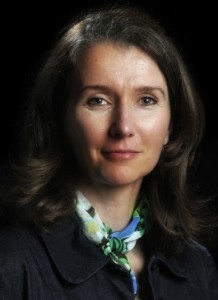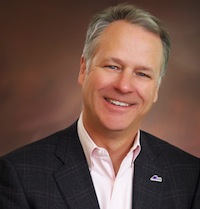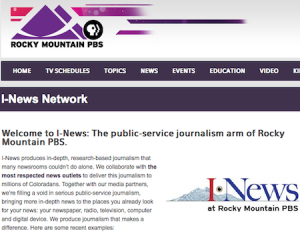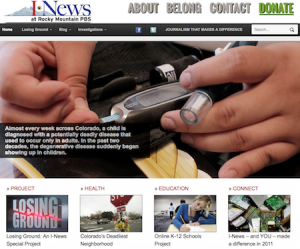About a year after journalist Laura Frank started the nonprofit investigative news start-up I-News in her kitchen, she moved into offices at Rocky Mountain PBS in downtown Denver.
From that humble beginning in 2009, she built, bit by bit, a half-million dollar news operation whose five-person team broke the kinds of news stories that changed laws and policy across the state.
“[We] have created the bandwagon for people to jump on.”
Then in January 2013, Frank – editor, fundraiser, partnership builder, business person – took on a new title. In addition to I-News executive director, she became vice president of news at Rocky Mountain PBS.

Laura Frank
More than taking on a new job, however, she stepped up to an overarching vision for Colorado public broadcasting that led to the nation’s first formal merger of a public broadcasting station with an indie news startup.
“We basically became the news operation of Rocky Mountain PBS,” she said.
For Doug Price, the president and CEO of Rocky Mountain PBS, the merger was a no-brainer, even though it means his network will now ultimately shoulder the tab for the I-News operation.
“We have a strategic vision around pertinence,” he said.
“We saw a void in the market and we think we can increase our memberships by filling that void, and we’re satisfied that we can do it without financial difficulty.”

Doug Price
A former bank executive, Price thinks in terms of big systems. Not content with being the flagship public broadcaster in the state, reaching one million viewers in Colorado, Wyoming, Nebraska and New Mexico, he is methodically investing in a new model for distribution that will get his broadcast assets moving “higher on all cylinders.”
And so along with the I-News merger, Rocky Mountain PBS entered into formal alliances with three of the state’s five major public radio stations, KUNC community radio for Northern Colorado in Greeley, KRCC in Colorado Springs and KVNF in Paonia. As well, it formally merged with KUVO, a mostly Latino jazz radio station.
“We wanted to see what the audience of the future is in Colorado and how we begin to serve them,” he said. “We wanted to be demographically, geographically and economically broad.”
He also seeks to create a distribution stream that can be “narrowcast, not just broadcast, and have a focus on improving civic life.”
stream that can be “narrowcast, not just broadcast, and have a focus on improving civic life.”
To sustain these new activities, Price projects that RMPBS needs to increase its members by 10 percent and its average gifts by 10 percent.
The merger announcement was timed to coincide with I-News’ ground-breaking “Losing Ground” special report, which used census data to document in five parts and an e-book, how the state’s black and Latino residents are falling farther and farther behind white residents.
That kind of enterprise reporting – offered to every news outlet in the state and combined with a long tail of roundtables, discussions and follow-up stories – is exactly what Price had in mind when he offered to merge with I-News rather than just pay for content. He envisions more “subterranean stories,” so deep, he said, they can support months of follow-ups and have real impact.
“We got lucky,” Price said. “In the first week of ‘Losing Ground’ every single daily except one carried it on the front page of their Sunday edition.”
“I love the series,” wrote general manager Scott Stanford, on the Steamboat [Springs] Pilot & Today website. “I can’t wait to publish the next project.”
Indeed, even Colorado Public Radio, which is not a formal part of what RMPBS is doing, has run multiple stories.
 “Losing Ground” is the kind of journalism that paved the way for I-News to partner with some 100 news outlets around the state. Some of the larger newspapers had even offered to pay for I-News content in recent years until those fees fell victim to relentless newsroom cost cutting.
“Losing Ground” is the kind of journalism that paved the way for I-News to partner with some 100 news outlets around the state. Some of the larger newspapers had even offered to pay for I-News content in recent years until those fees fell victim to relentless newsroom cost cutting.
“Then we started trading chickens,” Frank said. For instance, she said, one partner might work on graphic. Another might put in a house ad for I-News’ summer camp.
Even with the merger, I-News will still distribute its journalism to its network of partners. However, Frank said she has been very upfront in discussing the merger with them. “There will have to be some kind of contribution, either in kind or real money” to help support I-News’ deep dives.
The merger is seen as a win-win for both parties. The fact that RMPBS had no newsroom meant there were no issues of merging newsroom cultures.
“When you look at what we were doing and all the impact we’ve had – laws that have changed, changed policy – this is what public media ought to be doing,” Frank said. “They can either build it from scratch or use our stuff.”
While RMPBS has gained a newsroom, I-News got “an infrastructure that would have taken us years to build,” Frank said. “We now have 65,000 members.”
I-News had contracted with a fundraising consultant who recommended a goal of securing 5,000 members, Frank said. “It would have been a heavy lift to get to 65,000 members.”
 The merger by no means liberates Frank from fundraising, but she now can participate in some joint fundraising meetings with RMPBS. Moreover, her staff members, as RMPBS employees, now get health and other benefits.
The merger by no means liberates Frank from fundraising, but she now can participate in some joint fundraising meetings with RMPBS. Moreover, her staff members, as RMPBS employees, now get health and other benefits.
Price said he was motivated by diminishing newspapers, changing TV and the “declining amount of high-value journalism.”
He saw I-News’ objective as “laudable.” Education News Colorado is also located in his building. He also sees opportunities for more arts and culture reporting and journalism around STEM issues.
“We had this perspective that public media needs a lot of reform. Nostalgia is the enemy. History is the guide,” he said.
“We tell our people we have to train ourselves [to move] from a linear manufacturing company of the ’50s to a tech company” of today.
Key to that is creating content that moves across many distribution platforms and via many distribution partners and can be shared geographically through the web, applications and social media.
While the public broadcasting network may not be able to do daily reporting, “we can have great impact,” he said. “From my banking days, if we did a thoughtful review of what our system should be, content should always be married to distribution.”
“Primarily we are an educational institution,” Price said. So he’s also looking to partner with such entities as universities and libraries “to create value over time” and long-lived impact.
“Given the trust PBS has, everyone is very cognizant of not putting the thumb on the scale,” he said. But he forthrightly embraces a more involved mission than do some public stations who “tend to be more aloof and don’t want to be tainted mixing it up with too many partners.”
“We follow much more of the Mother Teresa approach,” he said. “Some careful news organizations might not see that in their best interests.”
Frank now also takes charge of the network’s weekly “Colorado State of Mind” program. She says her sponsors have applauded the idea of the merger.
“One of them told me: You have created the bandwagon for people to jump on.”


